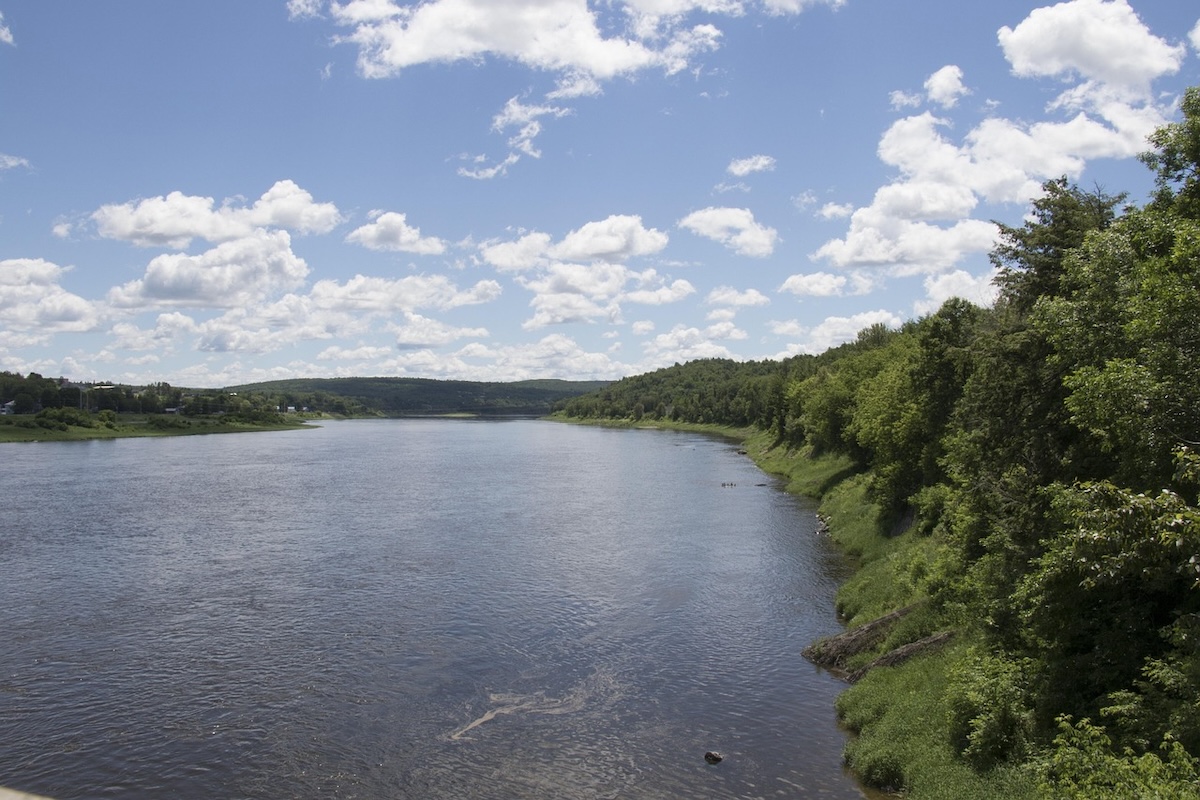
Did You Know There’s Canadian River That Flows Backwards? Here’s How the Saint John River Reverses Twice a Day!
By: Sarah Stone
Skip to Section
We all know rivers flow downhill, right? Water tumbles from mountains to valleys, from high ground to low, always seeking the path of least resistance on its journey to the sea. It’s a fundamental law of nature.
Or is it?
The Saint John River stretches 418 miles from its source in northern Maine through New Brunswick and along the Quebec border before emptying into the Bay of Fundy. For most of its journey, it behaves like any other river, flowing in a single direction. But near its mouth at the Bay of Fundy, something strange happens.
As the tide rises in the bay, the incoming water becomes so powerful that it pushes the river back onto itself. The current reverses completely, causing the Saint John to flow upstream. This isn’t a slight disturbance or ripple effect. In fact, it’s a full reversal that sends water rushing backward for miles!
Why does this happen? Well, the Bay of Fundy is home to the highest tides in the world. Twice daily, the bay experiences tidal shifts of 30+ feet—that’s a three-plus-story building by comparison. When these massive tides roll in, they slam into the river’s outflow with such force that the fresh water has nowhere to go but back where it came from.
The geography of the river mouth amplifies this effect. The Saint John empties into the bay through a narrow gorge known as the Reversing Falls Rapids. This natural bottleneck creates a funnel where the river and sea battle for dominance. At high tide, the sea wins, forcing the river to retreat. At low tide, the river reclaims its rightful path to the ocean.
The reversal generates dramatic rapids, whirlpools, and standing waves that transform the river into a churning cauldron of white water. At the height of the reversal, the water level can rise by 14 feet in just a few hours.
Even more interesting: the river follows a predictable cosmic schedule! The reversals coincide with the lunar cycle, which drives the Bay of Fundy’s tides (these occur about every 12 hours and 25 minutes).
The river’s daily change in flow has also shaped a unique ecosystem. The mixing of salt and fresh water creates a brackish environment where organisms must adapt to rapidly changing conditions or risk being swept away.
Fish that live in these waters have developed specialized behaviors to navigate the changing currents. Atlantic salmon, for instance, time their upstream migrations to coincide with the incoming tide, hitching a free ride against the river’s usual flow. Local fishermen have adapted too, setting different types of nets depending on which way the water is moving.
The reversal also acts as a natural mixing machine, churning up nutrients from the riverbed and bringing in mineral-rich seawater. This creates a fertile feeding ground that supports everything from tiny plankton to harbor seals.
While the Saint John’s reversal is particularly dramatic, it’s not the only river that flows backward at times. Maine’s Kennebec River experiences similar tidal effects, as does the Severn in the United Kingdom and parts of the Amazon River in Brazil.
What makes these reversals possible is always the same basic formula: a powerful tidal system meeting a river in a geography that amplifies rather than dampens the effect. The Bay of Fundy’s massive tidal range simply creates one of the most extreme examples on Earth.
For travelers hoping to witness this geographical oddity, timing is very important. Local tour operators have built an entire industry around this predictability, offering tours timed perfectly to catch the moment of reversal. Skywalk Saint John has great views, with a glass platform extending over the gorge. Local visitor centers post daily reversal schedules, though these times can shift with weather conditions and seasonal variations.
You can get the most spectacular viewings during spring tides—the highest tides of the month that occur during new and full moons. During these periods, the reversal becomes even more dramatic, with larger rapids and more pronounced effects traveling further upstream.
Have you had the chance to see a backward-flowing river? Share your stories and insights with the Frayed Passport community!
About the Author
 As the editor-in-chief of Frayed Passport, my goal is to help you build a lifestyle that lets you travel the world whenever you want and however long you want, and not worry about where your next paycheck will come from. I've been to 20+ countries and five continents, lived for years as a full-time digital nomad, and have worked completely remotely since 2015. If you would like to share your story with our community, or partner with Frayed Passport, get in touch with me using the form on our About page.
As the editor-in-chief of Frayed Passport, my goal is to help you build a lifestyle that lets you travel the world whenever you want and however long you want, and not worry about where your next paycheck will come from. I've been to 20+ countries and five continents, lived for years as a full-time digital nomad, and have worked completely remotely since 2015. If you would like to share your story with our community, or partner with Frayed Passport, get in touch with me using the form on our About page.Information published on this website and across our networks can change over time. Stories and recommendations reflect the subjective opinions of our writers. You should consult multiple sources to ensure you have the most current, safe, and correct details for your own research and plans.
Frayed Passport is a participant in the Amazon Associates Program, an affiliate advertising program designed to provide a means for sites to earn advertising fees by advertising and linking to Amazon.com. We also may share links to other affiliates and sponsors in articles across our website.




